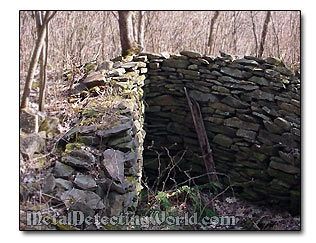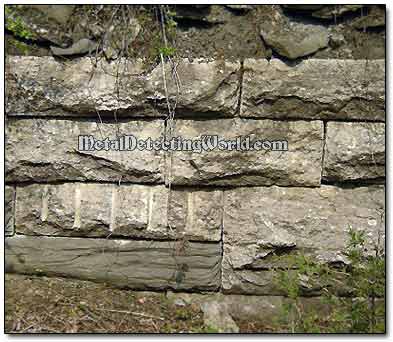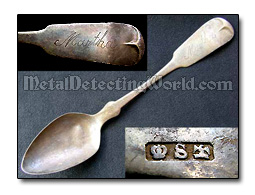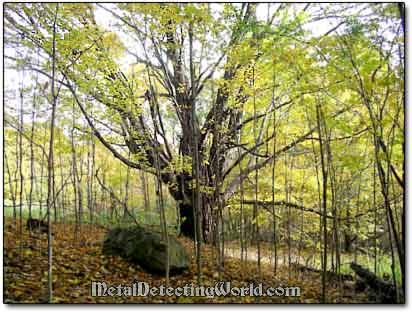How To Search a Former Homestead Site Located in Woods, page 5
Strategy for Metal Detecting at Unsearched ("Virgin") Site with Cellar Hole(s)

When you arrive at the hunt site, survey the site area and the immediate surroundings to determine the full extent of the site. First, focus on the most logical places to conduct your search. What matters the most is how well you analyze what you see and notice, and deduce what actions caused people to lose coins and other items in the past.
When only a cellar hole - a rectangular hole inlaid with stones or just a square depression inside the earth mound, remains on the site, try to determine first which side used to be the front of the house.
A front yard should be your primary objective before other areas are searched because the front yard will usually contain the least amount of metallic discards.
Though many early houses were built facing the roadway that led to them, some houses were built facing south to catch the winter sun through numerous windows. In this case, look for the accumulations of window glass fragments usually visible on the ground surface.
Another way to locate the front yard is to find the remains of an outhouse pit (a small square or round depression). Normally outhouses would be placed to the east of the house, as the prevailing winds would be blowing from the west, or in the backyard, out of public view.
The flat and large front-step stones also indicate the front of the house, but they, along with flat field or sidewalk stones, very seldom remain at the site.
Such stones were prizes sought after by other home builders who later came across these abandoned homestead sites. Nowadays, the flat large slabs of blue stone recovered from any abandoned homestead site are still in high demand and sold for big bucks!

Slabs in Old Foundation
Search carefully the crevices and cracks between the front-step stones as a few coins likely were dropped at this spot, fell through the stones, and still remain in vertical position there.

Side yards often contain the greatest quantity of coins and other valuables lost by former inhabitants. A definite indicator that you are on a side yard would be finding a spoon or a brass reed plate from a harmonica.
Inhabitants and their guests would normally have picnics and singing/dancing parties in the side yard during the summertime. Here you will likely find rings, necklaces, lockets, match cases, pewter toys, buttons and a variety of coins.
Side yards normally had a greater number of shade trees under which families would gather escaping the summer afternoon heat. If you spot the remains of a big tree, especially the first-growth tree which, as a rule, was one of a few trees spared at the property, search entire area around it. Coin caches were often buried under such trees - the best landmarks which would survive the fires and any natural disaster.

This Big Tree Marks the Location of a Cellar Hole Situated Next to It